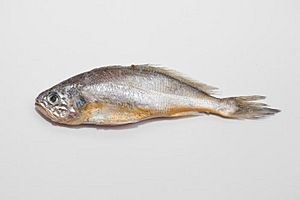Larimichthys polyactis facts for kids
Quick facts for kids Small yellow croaker |
|
|---|---|
 |
|
| Scientific classification | |
| Synonyms | |
|
Pseudosciaena polyactis Bleeker, 1877 |
The Small Yellow Croaker (scientific name: Larimichthys polyactis) is a type of fish. It's also known as the redlip croaker or yellow corvina. This fish lives in the western Pacific Ocean. You can find it in cooler waters, like the East China Sea and the Yellow Sea.
Contents
How the Small Yellow Croaker Evolved
Scientists study how different animals are related. They believe the small yellow croaker came from a shared ancestor. This ancestor was also the ancestor of another fish, Larimichthys crocea. This happened about 25.4 million years ago.
What the Small Yellow Croaker Eats
Small yellow croakers are benthopelagic feeders. This means they look for food near the bottom of the sea. They usually eat small shrimp or tiny ocean creatures called zooplankton. Sometimes, they might even eat smaller fish.
Where the Small Yellow Croaker Lives
These fish prefer shallow waters. They usually stay in areas less than 120 meters deep. They do not like water that is a mix of fresh and salt water (brackish conditions). You will typically find them where the sea floor is sandy or muddy.
What the Small Yellow Croaker Looks Like
Male small yellow croakers can grow up to 42 centimeters long. However, they are usually around 30 centimeters long. Their body shape is almost like a rectangle. They have bright red lips and a grey-gold body. Their belly is gold, and their fins are light yellow.
The inside of their mouth is white, and their gill slit is black. Inside their head, they have two hard, pale white bones. These bones help them keep their balance while swimming. These bones are also sometimes used in medicine. Small yellow croakers can make noise by moving their air bladder. This helps them stay together in groups.
Small Yellow Croaker Behavior and Life Cycle
These fish sometimes leap out of the water. In winter, they move to warmer waters to stay comfortable. Their breeding season is from March to June. During this time, a female fish can lay a lot of eggs. They usually lay between 30,000 and 70,000 eggs.
How Humans Interact with the Small Yellow Croaker
The small yellow croaker was once a very common fish. People caught a lot of them for food in China, Korea, and Japan. But in the 1970s, their numbers dropped a lot. This happened because of overfishing, which means too many fish were caught.
Later, the number of fish started to grow again. In 2008, about 388,018 tons of these fish were caught worldwide. When salted and dried, they become a popular food called gulbi (굴비) in Korean. Yeonggwang gulbi is a very special and expensive type of this dried fish. It can sell for over $100 for just one bunch!
See also
 In Spanish: Larimichthys polyactis para niños
In Spanish: Larimichthys polyactis para niños

